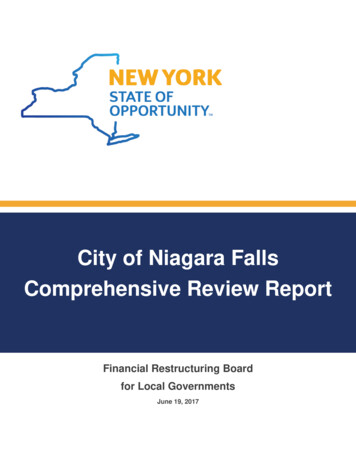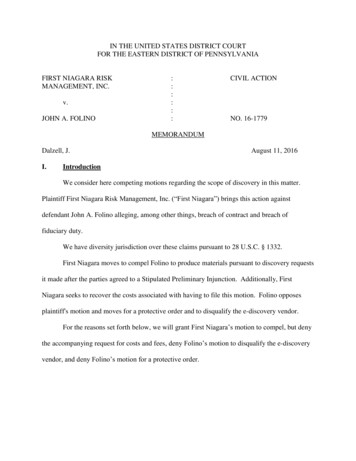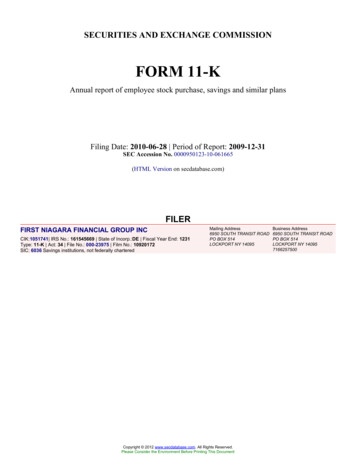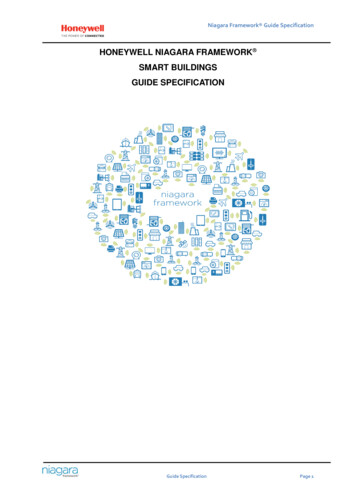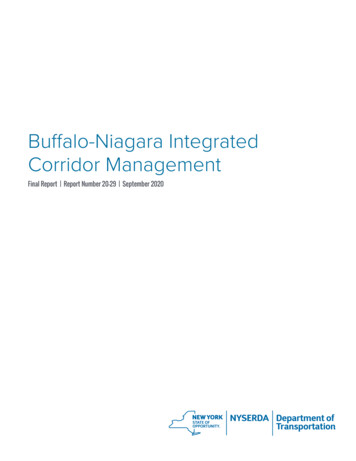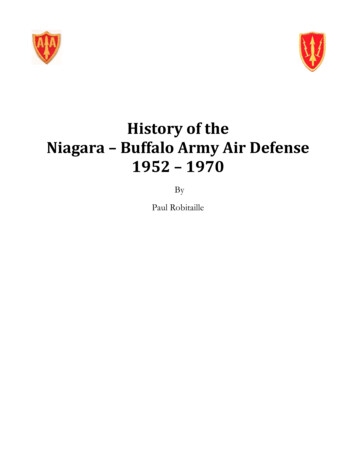
Transcription
COMPETITIVE REGION
Chapter 4 – Competitive Region4.1The Agricultural SystemThe agricultural system contains a structure for the agricultural land base and the agrifood network that enables the agri-food sector to thrive.The agricultural land base is comprised of prime agricultural areas, including specialtycrop areas, and rural lands. The agri-food network includes infrastructure, services andassets important to the viability of the agri-food sector. Farm stewardship facilitatesagricultural protection and the environmental benefits of natural heritage featureslocated throughout the agricultural system.Together, the Region’s agricultural system and natural environment system provide asignificant contribution to Niagara’s resilience and ability to adapt to climate change.The agricultural land base will be protected for the provision of healthy, local food forpresent and future generations. Farming will be productive, diverse, and sustainable.The objectives of this section are as follows:a) facilitate a strong, diverse, and resilientagricultural economy;b) protect the region’s agricultural landbase;c) ensure agriculture is the predominantland use in specialty crop areas andprime agricultural areas;d) restrict and control non-agricultural usesto minimize potential conflicts;Niagara’s Agricultural EconomyNiagara region is home to an activeand vibrant farming sector, whichincludes a wide range of farmingtypes including grape and tenderfruit; greenhouse, nursery,floriculture operations; oilseeds andgrain operations; livestockoperations, and more. In Niagara,farmland generates over 1.4 billionGDP from agriculture and has a highemployment impact for the region.e) ensure the long-term sustainability andfunction of uses within the agricultural system;f) protect specialty crop areas from fragmentation;g) protect prime agricultural areas from fragmentation;h) protect and recognize rural lands as part of the agricultural system;i) provide for a limited amount of non-agricultural residential development on rurallands; andj) recognize and control changes to existing uses to ensure a viable agriculturalsystem.RECOMMENDED PLAN JUNE 2022101COMPETITIVE REGION
4.1.1 Region’s Agricultural Land Base4.1.1.1The geographic continuity of the agricultural land base, as shown inSchedule F, and the functional and economic connections to the agrifood network will be maintained and enhanced in accordance withthe policies of this section.4.1.1.2Prime agricultural areas and specialty crop areas, as shown onSchedule F, shall be protected for long-term use for agriculture.Prime agricultural areas are areas where prime agricultural landspredominate. Specialty crop areas shall be given the highest priorityfor protection, followed by Canada Land Inventory Class 1, 2, and 3lands, and any associated Class 4 through 7 lands within the primeagricultural area, in this order of priority.4.1.1.3Settlement areas are not permitted to expand into specialty cropareas.4.1.1.4An agricultural system has been identified in which all types, sizes,and intensities of agricultural uses and normal farm practices shall bepromoted and protected in accordance with Provincial standards.Removal of land from prime agricultural areas may only occur forexpansions or identification of settlement areas in accordance withSection 2.2.5 of this Plan. Revisions to the Greenbelt Plan andNiagara Escarpment Plan boundaries and redesignation of specialtycrop areas are prohibited.4.1.1.5The removal of topsoil in specialty crop areas, prime agriculturalareas, and rural lands is discouraged. Further, the placement of fill inspecialty crop areas and prime agricultural areas is prohibited. LocalArea Municipalities are encouraged to enact by-laws to regulate theplacement of fill in accordance with Section 3.7 of this Plan.4.1.2 Specialty Crop Areas and Prime Agricultural Areas4.1.2.1Specialty crop areas shall not be redesignated in official plans fornon-agricultural uses. Non-agricultural uses may be permittedsubject to Policies 4.2 to 4.6 of the Greenbelt Plan and Section 4.1.3of this Plan.4.1.2.2In specialty crop areas, all existing uses lawfully used for suchpurpose prior to December 16, 2004. In specialty crop areas, singledetached dwellings and accessory structures are permitted onexisting lots of record, provided they were zoned for such orpermitted through other regulation as of December 16, 2004.RECOMMENDED PLAN JUNE 2022102COMPETITIVE REGION
4.1.2.3In specialty crop areas and prime agricultural areas, all types, sizesand intensities of agricultural uses and normal farm practices shall bepromoted and protected and a full range of agricultural uses,agriculture-related uses and on-farm diversified uses are permitted.4.1.2.4Prime agricultural areas within the Greenbelt Plan as identified onSchedule F are subject to the prime agricultural area policies of thisPlan.4.1.3 Minimize Conflicts of Non-Agricultural Uses4.1.3.1Non-agricultural uses should not be located in specialty crop areas orprime agricultural areas.4.1.3.2Non-agricultural uses must address Greenbelt Plan policies for nonagricultural uses in speciality crop areas and prime agricultural areas.4.1.3.3Applications for non-agricultural uses shall require completion of anagricultural impact assessment.4.1.3.4In specialty crop areas lands shall not be redesignated in officialplans for non-agricultural uses.4.1.3.5In prime agricultural areas lands shall not be redesignated in officialplans for non-agricultural uses except for:a) refinements to the prime agricultural area and rural landsdesignations, subject to the policies of Section 5.3 of theGreenbelt Plan; orb) settlement area boundary expansions, subject to Policies 3.4.1 to3.4.5 of the Greenbelt Plan.4.1.3.6New land uses in specialty crop areas and prime agricultural areas,including the creation of lots, and new or expanding livestockfacilities, shall comply with the minimum distance separationformulae.4.1.3.7Where agricultural uses and non-agricultural uses interface, land usecompatibility shall be achieved by avoiding or, where avoidance isnot possible, minimizing and mitigating adverse impacts on theagricultural system, by incorporating measures as part of new orexpanding non-agricultural uses, as appropriate, within the areabeing developed.4.1.4 Lot Creation and Related Development Within the Agricultural System4.1.4.1Within the prime agricultural area, including the protected countrysideof the Greenbelt Plan which also includes specialty crop area, lotRECOMMENDED PLAN JUNE 2022103COMPETITIVE REGION
creation is discouraged and may only be permitted in accordancewith the policies in Sections 4.1.4, 4.1.5 and 4.1.6 of this Plan.4.1.4.2Proposed residential lots being considered under Sections 4.1.5 and4.1.6 for a consent within the agricultural land base must meet thefollowing conditions:a) the size of any new lot shall be an area of 0.4 hectares exceptto the extent of any additional area deemed necessary tosupport an on-site private water supply and long-term operationof a private sewage disposal system as determined byProvincial and Regional requirements;b) any new lot has an adequate groundwater or other watersupply, in compliance with Provincial requirements;c) any new lot has sufficient frontage on an existing publiclymaintained road;d) where possible, joint use should be made of the existing roadaccess to the farm operation;e) road access to any new lot does not create a traffic hazardbecause of limited sight lines on curves or grades or proximity tointersections;f) proposed lots shall be located and configured to minimizeimpacts on surrounding farming operations.4.1.4.3All proposed development and uses will include sustainable on-siteprivate water supply and private sewage disposal systems subject toapplicable Provincial and Regional regulations and associatedapprovals.4.1.5 Lot Creation in Specialty Crop Areas4.1.5.1In the specialty crop areas, consents to convey may be permittedonly in accordance with the following provisions and the generalconsent provisions in Policy 4.1.4.2. Within the Niagara EscarpmentPlan Area, the policies of the Niagara Escarpment Plan, as amendedfrom time to time, shall prevail unless the following policies are morerestrictive, then the more restrictive policies shall prevail.a) the consent is supported through a planning justification report;b) the consent is for an agricultural use where the severed andretained lots are intended for agricultural uses and provided theRECOMMENDED PLAN JUNE 2022104COMPETITIVE REGION
minimum lot size is 16 hectares for both the severed andretained lots;c) the consent is for an agriculture-related use, provided that anynew lot shall be limited to the minimum size needed toaccommodate the use and appropriate sewage and waterservices;d) the consent is for acquiring land for public infrastructurepurposes, where the facility or corridor cannot beaccommodated through the use of easements or rights of way,provided that:i.the need has been demonstrated and it has been establishedthat there is no reasonable alternative; andii.an agricultural impact assessment has been completed by aqualified professional;e) the consent is for facilitating conveyances to public bodies ornon-profit entities for natural heritage conservation, provided itdoes not create a separate lot for a residential dwelling;f) the consent is for legal or technical reasons as determined byLocal Area Municipalities, provided they do not create aseparate lot for a residential dwelling, there is no increasedfragmentation of a key natural heritage feature or key hydrologicfeature, and complies with other policies in this Plan; andg) the consent is for a residence surplus to a farming operation asoutlined in Policy 4.1.5.2.4.1.5.2The severance of a residence surplus to a farming operation may bepermitted under the following circumstances:a) the proposed lot contains a habitable residence, which existedas of December 16, 2004, that is rendered surplus as a result offarm consolidation;b) the size of any new lot shall be an area of 0.4 hectares exceptto the extent of any additional area deemed necessary tosupport an on-site private water supply and private sewagedisposal system as determined by Provincial and Regionalrequirements to a maximum of 1 hectare;i.proposals that exceed 1 hectare may be considered subjectto an amendment to this plan;RECOMMENDED PLAN JUNE 2022105COMPETITIVE REGION
c) to reduce fragmentation of the agricultural land base, theretained lot shall be merged with an abutting parcel. Wheremerging of two lots is not possible, the retained farm parcel shallbe zoned to preclude its use for residential purposes.4.1.6 Lot Creation in Prime Agricultural Areas4.1.6.1In prime agricultural areas outside of specialty crop areas, consentsto convey may be permitted only in those circumstances set out inthe following provisions and the general consent provisions ofPolicy 4.1.4.2:a) the consent is for agricultural uses, subject to the followingcriteria:i.the resulting parcels are both for agricultural uses;ii.the minimum lot size for the severed and retained lot is 40 ha,the resulting parcels meet the Local official plan andagriculture zoning provisions, and:1. is appropriate for the farming activities proposed;2. is suited to the particular location and common in thearea; and3. provides some flexibility for changes in the agriculturaloperation.b) the consent is for agriculture-related use subject to the followingcriteria:i.any new lot shall be limited to a minimum size needed toaccommodate the proposed use and appropriate sewage andwater services; andii.any new lot shall be zoned to preclude residential uses inperpetuity.c) the consent is for a residence surplus to a farming operation asoutlined in Policy 4.1.6.2;d) the consent is for a lot adjustment for legal or technical reasons;ore) the consent is for public infrastructure, where the facility orcorridor cannot be accommodated through the use ofeasements or rights-of-way.RECOMMENDED PLAN JUNE 2022106COMPETITIVE REGION
4.1.6.2The severance of a residence surplus to a farming operation may bepermitted under the following circumstances:a) the lot contains a habitable residence, which existed as of June16, 2006, that is rendered surplus as a result of farmconsolidation;b) the size of any new lot shall be an area of 0.4 hectares exceptto the extent of any additional area deemed necessary tosupport an on-site private water supply and private sewagedisposal system as determined by Provincial and Regionalrequirements to a maximum of 1 hectare;i.proposals that exceed 1 hectare may be considered subjectto an amendment to this plan; andc) to reduce fragmentation of the agricultural land base, theretained lot shall be merged with an abutting parcel. Wheremerging of two lots is not possible, the retained farm parcel shallbe zoned to preclude its use for residential purposes.4.1.7 A Resilient Agricultural Economy4.1.7.1The Region encourages the continued operation and expansion ofagricultural infrastructure including irrigation and drainage systemsas shown in Appendix 1.4.1.7.2Temporary accommodation forseasonal or full-time farm labourmay be permitted where:a) the size and/or nature of theagricultural operationsmakes the employment ofsuch help necessary;b) such temporaryaccommodation does nothave a significant effect onthe tillable area of theagricultural operation or itsviability; andAgri-Food StrategyAgri-food is a term that refersto all forms of commercialagricultural activity and allstages of food and beverageprocessing. The Niagararegion agri-food sectorcontributes significantly to theeconomic prosperity andquality of life of residents. Thestrategy looks to support agrifood prosperity andsustainability.c) the severance of a temporary accommodation for seasonal orfull-time farm labour is not permitted.4.1.7.3Agricultural uses, agriculture-related uses and on-farm diversifieduses are permitted in the following areas:RECOMMENDED PLAN JUNE 2022107COMPETITIVE REGION
a) specialty crop areas;b) prime agricultural areas; andc) rural lands.Table 4-1 Agricultural Uses, Agricultural-Related Uses and On-Farm DiversifiedUsesType of UseAgricultural UsesAgriculture-Related UsesOn-Farm Diversified UsesDescriptionGrowing of crops orraising of livestock;raising of other animalsfor food, fur or fibre;aquaculture; apiaries;agro-forestry; maplesyrup production; andassociated on-farmbuildings and structuresMay or may not be on afarm; farm-relatedcommercial or industrialuse; compatible withsurrounding agriculturaloperations; directly relatedto farms in the area;supports agriculture,provides products orservices to farms; benefitsfrom proximity to farmsOn a farm; secondary use;limited in area; includes, butis not limited to, homeoccupations, homeindustries, agri-tourism usesand value-added uses;compatible with surroundingagricultural operationsExamplesinclude, butare notlimited toa) Croplanda) Processing ofagricultural productsa) Agri-tourism usesb) Pasturelandc) Barns and otherassociated buildingsand structuresb) Farm equipment repairshopb) Pick-your-own operationc) Home occupationsc) Agriculture researchcentre4.1.7.4Proposed agriculture-related uses and on-farm diversified uses shallbe compatible with, and shall not hinder, surrounding agriculturaloperations.4.1.7.5Agriculture-related uses and on-farm diversified uses shall beconsistent with the provisions of the Provincial Policy Statement, andconform to the Growth Plan, Greenbelt Plan, and NiagaraEscarpment Plan.4.1.7.6On-farm diversified uses shall be:a) located on a farm;RECOMMENDED PLAN JUNE 2022108COMPETITIVE REGION
b) secondary to the principal agricultural use of the property;c) limited in area; andd) compatible with, and shall not hinder, surrounding agriculturaloperations.4.1.7.7The appropriate scale for on-farm diversified uses may varydepending on the type of use and whether the activities are locatedin the specialty crop area or in other prime agricultural areas. Thefollowing criteria shall be considered when reviewing applications forproposed agriculture-related uses:e) whether the proposed activity is more appropriately located in anearby settlement area or on rural lands;f) whether the use is required for or in close proximity to theagricultural operation for it to support and complement theagricultural activity;g) the extent to which the use is compatible with the existingfarming operation and surrounding farming operations;h) whether the scale of the activity is appropriate to the site andfarming operation;i) whether the use is consistent with and maintains the characterof the agricultural area;j) the use does not generate potentially conflicting off-site impacts;k) the activity does not include a new residential use;l) the use is limited to low water and low effluent producing usesand the site is capable of accommodating the use on privatewater and private sewage treatment systems;m) the use does not require significant improvements toinfrastructure; andn) the use complies with all other applicable provisions of this Plan.4.1.7.8Within the Niagara Escarpment Plan Area, the policies contained inthe Niagara Escarpment Plan apply. Agriculture-related uses and onfarm diversified uses must meet the permitted uses, developmentcriteria and policies of the Niagara Escarpment Plan.4.1.7.9Local Area Municipalities are encouraged to utilize site plan control toregulate the impact of agriculture-related uses and on-farmRECOMMENDED PLAN JUNE 2022109COMPETITIVE REGION
diversified uses, in relation to entrances, parking and loadingfacilities, signage, grading and storm water drainage, buffering andlandscaping, and landscape protection.4.1.8 Rural Lands as Part of the Agricultural System4.1.8.1The predominant use of rural lands will continue to be agriculture, butsome non-agricultural related development may be permitted subjectto the policies in Sections 4.1.8 and 4.1.9.4.1.8.2Permitted uses on rural lands include:a) management or use of resources in accordance with all otherapplicable provisions of this Plan;b) limited residential development in accordance with Section4.1.9;c) agricultural uses, agriculture-related uses, on-farm diversifieduses, normal farm practices, in accordance with this section;d) home occupations and home industries in accordance withLocal official plan and zoning by-law provisions;e) cemeteries; andf) other uses not described in this chapter may be permitted,subject to an amendment to this Plan.4.1.8.3The rural lands along the Lake Erie shoreline contain historic patternsof seasonal and permanent residential development. These uses andexpansions thereof continue to be permitted in accordance with Localofficial plans and zoning by-law provisions.4.1.9 Non-Agricultural Uses on Rural Lands4.1.9.1Limited non-agricultural residential development may be permitted onrural lands in accordance with the policies of this section.4.1.9.2Proposals for non-agricultural residential development on rural landsmust meet the following criteria and the general consent provisionsin Policy 4.1.4.2, in addition to the other requirements of this Plan,the Niagara Escarpment Plan and the Local official plan:a) a maximum of three new lots (in addition to the retained lot) maybe permitted on each lot in existence as of June 16, 2006;b) the minimum size of the proposed and retained lots shall eachbe 1 hectare unless it is determined through a hydrogeologicalstudy, that considers potential cumulative impacts, that aRECOMMENDED PLAN JUNE 2022110COMPETITIVE REGION
smaller size lot will adequately accommodate private water andsewage treatment facilities for long-term operation but not beless than 0.4 hectares;c) the development will be at a scale and density suitable to thephysical characteristics of the site;d) soil and drainage conditions are suitable and permit the propersiting of buildings, the supply of potable water and theinstallation and long-term operation of an adequate means ofwaste disposal;e) the proposed development will be consistent with Section 3.1;andf) proposed developments must be appropriately separated andprotected from:i.incompatible land uses such as existing pits and quarries;ii.mineral aggregate resources recognized in this Plan;iii.livestock operations and anaerobic digesters, in accordancewith the minimum distance separation formulae;iv.existing and former solid waste sites;v.major existing and proposed transportation facilities; andvi.employment uses.4.1.10 Non-Conforming Uses in the Agricultural System4.1.10.1This Plan shall not prohibit the continued operation of legallyestablished uses, such as residential, commercial, employment,agricultural, and institutional uses.4.1.10.2Expansions to existing buildings and structures, accessory structuresand existing uses, as well as conversions or redevelopment oflegally existing uses that bring the use more into conformity with thisPlan, are permitted subject to demonstration of the following:a) new municipal services are not required;b) the proposal does not expand into key natural heritage featuresand key hydrological features, unless there is no otheralternative in which case any expansion shall be limited inscope and kept within close geographical proximity to theexisting structure;RECOMMENDED PLAN JUNE 2022111COMPETITIVE REGION
c) if applicable, the proposed new use complies with the SpecialtyCrop Guidelines, as amended from time to time;d) for conversions or redevelopments only, the completion of anagricultural impact assessment by a qualified professional;e) the proposal does not result in the intrusion of new incompatibleuses; andf)the proposed use is in accordance with the minimum distanceseparation formulae.4.1.10.3Within the Niagara Escarpment Plan area, the Niagara EscarpmentPlan Policies also apply to existing uses.4.1.10.4In accordance with the developed shoreline area policies of theGreenbelt Plan and Growth Plan, notwithstanding Sections 4.1.1,4.1.2, 4.1.5, 4.1.6, 4.1.8, and 4.1.9 of this Plan, infill development,redevelopment, and resort development is permitted in developedshoreline areas of Lake Ontario, Lake Erie, and the Niagara Riverthat are designated or zoned for concentrations of development as ofJuly 1, 2017, subject to the following requirements. The developmentwill:a) enhance or be integrated with existing or proposed parks andtrails, such as the Great Lakes Waterfront Trail, and willenhance ongoing or planned stewardship and remediationefforts;b) restore, to the maximum extent possible, the ecological featuresand functions in development shoreline areas; andc) in the case of redevelopment and resort development:i.establish, or increase the extent and width of, a vegetationprotection zone along the shoreline to a minimum of 30metres;ii.increase the extent of fish habitat in the littoral zone;iii.be planned, designed, and constructed to protect hydrologicfunctions, minimize erosion, and avoid or mitigatesedimentation and the introduction of nutrient or otherpollutants into the lake;iv.exclude shoreline structures that will impede the natural flowof water or exacerbate algae concerns along the shoreline;RECOMMENDED PLAN JUNE 2022112COMPETITIVE REGION
v.enhance the ability of native plants and animals to use theshoreline as both wildlife habitat and a movement corridor;vi.use lot-level stormwater controls to reduce stormwater runoffvolumes and pollutant loadings;vii.use natural shoreline treatments, where practical, forshoreline stabilization, erosion control, or protection;viii.meet other criteria and direction set out in applicablewatershed planning and subwatershed plans;ix.be serviced by sewage works which reduce nutrient inputs togroundwater and the receiving water body from baselinelevels; andx.demonstrate available capacity in the receiving water bodybased on inputs from existing and approved development.RECOMMENDED PLAN JUNE 2022113COMPETITIVE REGION
4.2Planning for EmploymentThe Region is required to plan for and protect lands to accommodate the Province’sforecasted employment growth coming to Niagara. These lands will play a critical role inthe ability to retain and attract employment investment that contributes to Niagara’seconomic competitiveness on provincial, national, and global scales. The provision oflands for employment is an important component of complete communities.The policies encourage employment development inurban areas and recognizes the contribution of ruralemployment in the agricultural community towardNiagara’s prosperity. Emphasis is on fosteringcommunities that attract people, jobs, and investment,while protecting employment uses for the long-term.The objectives of this section are as follows:a) designate employment areas for long-termprotection and plan for forecasted employmentgrowth within employment areas;Employment Lands andEmployment AreasThe Region maps anddevelops policies foremployment areas. LocalArea Municipalities mapand develop polices foremployments lands.b) maximize the economic development potential of the Niagara Economic Centreand Zone;c) identify and consider future employment areas in long-term planning forsettlement area expansion;d) plan employment lands to enhance economic resilience through a diversifiedeconomy;e) guide future redevelopment of employment lands;f) protect airport and aerodrome lands short-term and long-term operational needs;g) enhance rural employment lands within rural settlements and recognize ruralemployment lands outside of rural settlements; andh) identify opportunities for strategic investments that further economic prosperity.RECOMMENDED PLAN JUNE 2022114COMPETITIVE REGION
4.2.1 Employment Area Types and Densities4.2.1.1Niagara's employment areas are shown on Schedules B and G.4.2.1.2The following are prohibited in all employment areas:a) residential uses;b) major retail / major commercial uses; andc) major office, except major office is permitted on employmentarea lands within a strategic growth area.4.2.1.3Sensitive land uses that are not ancillary to the primary employmentuse shall be limited in employment areas and only permitted if suchuse can comply with D-6 Guidelines.4.2.1.4Employment areas are classified in three types, as identified onSchedule G and Table 4-2.4.2.1.5Core employment areas are cluster of traditional employment uses,such as industrial, manufacturing, construction, transportation andwarehousing. Core employment areas shall be protected andplanned for similar employment uses, major facilities, and freightsupportive forms of development and redevelopment. Majorinstitutional uses are prohibited in core employment areas.4.2.1.6Dynamic employment areas are clusters of traditional and lighterindustrial uses with a broader mix of employment uses includingoffice parks and institutional uses that can function without limitingthe viability of one another. A mix of complementary employmentuses will be encouraged through development or redevelopmentwithin dynamic employment areas that do not limit the ability for otheremployment uses within the employment area to grow or expand.4.2.1.7Knowledge and Innovation employment areas are clusters of higherdensity employment uses, including office parks, and majorinstitutional uses. Knowledge and Innovation employment areas will:a) contain a mix of complementary land uses to facilitatepartnerships and promote the sharing of ideas and information;b) accommodate built form that supports nearby major institutionaluses and major office uses where permitted;c) attain high-quality urban design;d) encourage densities that are transit-supportive; andRECOMMENDED PLAN JUNE 2022115COMPETITIVE REGION
e) incorporate active transportation facilities along activetransportation networks.4.2.1.8Local area municipalities shall map employment areas shown onSchedule G in Local official plans.4.2.1.9The Region and Local Area Municipalities shall plan for existingemployment areas to achieve the minimum density targets to 2051identified in Table 4-2.Table 4-2 Employment Area Minimum Density Targets to 2051Employment AreaSub-GroupingLocal AreaMunicipalityCoreFort ErieDynamicFort ErieCoreCoreFort colnLincolnCoreNiagara FallsCoreNiagara FallsDynamicNiagara FallsDynamicNiagara FallsDynamicNiagara FallsCoreNiagara FallsDynamicNiagara rt ColborneKnowledge andInnovationCoreRECOMMENDED PLAN JUNE 2022Employment Area(see Schedule G)FE-1 Stevensville IndustrialCellFE-2 International PeaceBridge Trade HubFE-3 Bridgeburg Rail ZoneGRM-1 West Niagara QEWCorridorGRM-2 Casablanca-East QEWCorridorGRM-3 Main Street EastEmployment DistrictLIN-1 Beamsville GO PrecinctLIN-2 King Street at BartlettJunctionNF-1 Highway 405Employment AreaNF-2 North Niagara FallsSecure Storage EmploymentAreaNF-3 QEW / 420 EmploymentAreaNF-4 QEW Centre EmploymentAreaNF-5 Montrose Road IndustrialAreaNF-6 Dorchester RoadEmployment AreaNF-7 Stanley Avenue BusinessParkNOTL-1 Virgil Business ParkNOTL-2 Glendale MomentumDistrictPC-1 Port Colborne WestTransshipment Terminal116Minimum OverallDensity Target(jobs per hectare)15 jobs/ha15 jobs/ha10 jobs/ha45 jobs/ha45 jobs/ha40 jobs/ha30 jobs/ha10jobs/ha15 jobs/ha15 jobs/ha25 jobs/ha50 jobs/ha20 jobs/ha45 jobs/ha15 jobs/ha35 jobs/ha60 jobs/ha10 jobs/haCOMPETITIVE REGION
Employment AreaSub-GroupingLocal AreaMunicipalityCorePort ColborneCoreSt. CatharinesKnowledge andInnovationDynamicSt. CatharinesDynamicSt. CatharinesDynamicSt. CatharinesCoreSt. CatharinesKnowledge oreWest LincolnSt. CatharinesThoroldMinimum OverallDensity Target(jobs per hectare)Employment Area(see Schedule G)PC-2 Port Colborne EastTransshipment TerminalSTC-1 Port Weller EmploymentAreaSTC-2 Hannover EmploymentAreaSTC-3 Hiscott EmploymentAreaSTC-4 B
Schedule F, and the functional and economic connections to the agri-food network will be maintained and enhanced in accordance with the policies of this section. Prime agricultural ar eas and specialty crop ar eas, as shown on Schedule F, shall be protected for long-term use for agriculture. Prime agricultural ar eas are areas where


